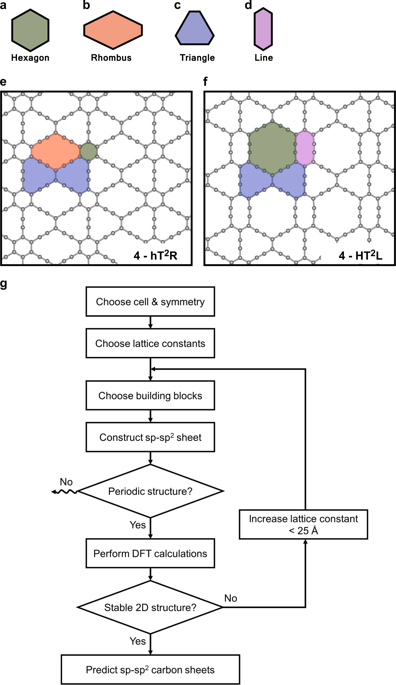npj Computational Materials ( IF 9.4 ) Pub Date : 2018-10-18 , DOI: 10.1038/s41524-018-0113-8 Minwoo Park , Youngkuk Kim , Hoonkyung Lee

|
Grapheneis a massless Dirac fermion system, featuring Dirac points in momentum space. It was also first identified as a quantum spin Hall (QSH) insulator when considering spin–orbit coupling (SOC), which opens a band gap at the Dirac points. This discovery has initiated new research efforts to study the QSH effect, towards its application for quantum computing and spintronics. Although the QSH effect has been observed in HgTe quantum wells, the SOC strength of graphene is too small (~1 µeV) to induce the topological insulator phase in an experimentally achievable temperature regime. Here, we perform a systematic atomistic simulation to design two-dimensional sp–sp2 hybrid carbon sheets to discover new Dirac systems, hosting the QSH phase. 21 out of 31 newly discovered carbon sheets are identified as Dirac fermion systems without SOC, distinct from graphene in the number, shape, and position of the Dirac cones occurring in the Brillouin zone. Moreover, we find 19 out of the 21 new Dirac fermion systems become QSH insulators with a sizable SOC gap enhanced up to an order of meV, thus allowing for the QSH effect at experimentally accessible temperatures. In addition, based on the 26 Dirac fermion systems, we make a connection between the number of Dirac points without SOC and the resultant QSH phase in the presence of SOC. Our findings present new prospects for the design of topological materials with desired properties.
中文翻译:

基于sp–sp 2碳片的二维无质量Dirac费米子系统和量子自旋霍尔绝缘体的设计
石墨烯是无质量的狄拉克费米子系统,其动量空间具有狄拉克点。考虑自旋轨道耦合(SOC)时,它也首先被确定为量子自旋霍尔(QSH)绝缘体,这在Dirac点上打开了带隙。这项发现启动了新的研究工作,以研究QSH效应,并将其应用于量子计算和自旋电子学。尽管已在HgTe量子阱中观察到QSH效应,但石墨烯的SOC强度太小(〜1 µeV),无法在实验上可达到的温度范围内诱发拓扑绝缘体相。在这里,我们执行系统的原子模拟,以设计二维sp–sp 2混合碳板,以发现新的Dirac系统,并主持QSH阶段。在31个新发现的碳层中,有21个被识别为没有SOC的狄拉克费米子系统,在布里渊区中出现的狄拉克锥的数量,形状和位置与石墨烯不同。此外,我们发现21个新的狄拉克费米子系统中有19个成为QSH绝缘体,其SOC间隙提高到meV的数量级,从而允许在实验可及的温度下实现QSH效应。此外,基于26个Dirac费米子系统,我们在没有SOC的Dirac点数与存在SOC的情况下生成的QSH相之间建立了联系。我们的发现为具有所需特性的拓扑材料设计提供了新的前景。











































 京公网安备 11010802027423号
京公网安备 11010802027423号